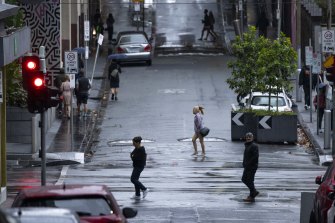
Her firm, Gehl Architects, was one of the lead voices behind the Danish capital’s conversion into one of the world’s most pedestrian-friendly cities.
Road access to every part of a city will always be necessary for emergency vehicles, along with disabled access and services such as waste disposal.
As growing populations increase pressure on space, however, Ms Vamberg believes every city should be asking: how low can you go?
Deliveries to businesses, from restaurants to retail stores, are one sticking point.
Mike McNess, Victorian secretary of the Transport Workers’ Union, which represents delivery and rideshare drivers, believes a car-free CBD may have some merit but would make delivery drivers’ already difficult job much harder.
“Finding somewhere safe and legal to park has always been hard, and the implementation of more bike lanes during the pandemic has eliminated a lot of loading zones,” he says.

‘Little’ streets such as Little Lonsdale Street are pedestrian-friendly zones already.Credit:Wayne Taylor
One alternative was recently implemented in the Dutch city of Groningen. There, delivery workers are encouraged to collect items from hubs on the edge of the city centre before entering on electric cargo bikes similar to ones used by Australia Post.
From 2025, all new delivery vehicles in Groningen must be electric.
How would you do it?
Melbourne’s CBD enjoys more favourable characteristics than the likes of hilly Sydney: flat roads, a grid layout and a combination of multi-lane roads and quaint laneways.
About 89 per cent of trips that start and end in the CBD are on foot, according to Melbourne City Council, yet cars and parking utilise 60 per cent of road space.
“Little” streets, such as Little Collins and Little Lonsdale streets, could be a logical starting point for a car-free CBD, according to Vaughn Allan, a Melbourne-based planner with the Institute for Sensible Transport.
The council designated them pedestrian-priority zones in its 2030 transport strategy, restricting speed limits to as low as 10 kilometres per hour in some areas.
“Ultimately you’d need a broader view of the area around the CBD as well as within it,” Mr Allan says.
“Trams and buses moving through inner-city suburbs like Richmond, Collingwood and South Yarra spend peak hour stuck behind cars. If you want people reaching the city on public transport and bikes, it means making those main streets car-lighter too.”
Where else is moving away from cars?
When Oslo announced plans to make the city centre entirely vehicle-free to hit its zero emissions by 2030 target, it was met with vehement opposition, particularly from businesses.
The city council shifted to a three-phase approach, removing on-street parking; closing select streets to vehicles; and altering traffic routes. Car usage has since dropped 19 per cent and within a year there were 10 per cent more shoppers in the Norwegian capital’s city centre.
Yet in a sign of similar business sentiment locally, Victorian Chamber of Commerce chief executive Paul Guerra says he will not be supportive of a car-free Melbourne CBD.
“We are already seeing the impacts of reducing access and carparking in the CBD as we continue our post-COVID-19 recoveries, which has made it harder for individuals and businesses,” he says.
Barcelona’s “super blocks” model assigns areas of 400 by 400 metres that can only be crossed by residents, disabled people and emergency services in vehicles, along with bicycles and those on foot.
The City of Melbourne floated the idea of super blocks in 2018. As an example the city could look towards, lord mayor Sally Capp cited London, where bike lanes and congestion charges came in over a decade ago.
Capp believes there will never be a Melbourne entirely free of private vehicles. But she says the trend towards pedestrianisation is clear.
In a 2019 survey that informed the council’s 2030 transport strategy, only 5 per cent of respondents suggested car-free zones were a bad idea.
“We’ve got a lot of challenges on how we take existing space made available for transport and we rebalance that,” she said at a Melbourne Press Club address earlier this month.
The Morning Edition newsletter is our guide to the day’s most important and interesting stories, analysis and insights. Sign up here.









 Add Category
Add Category